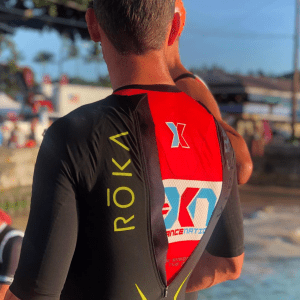Solving the triathlon swim puzzle can seem like a daunting task. Another season, and more news of tragic deaths in the swim portion of an Ironman® event. Without a doubt, participating in endurance events brings risks and challenges beyond what the average middle-aged person experiences on a daily basis.
While tragedy can strike at any time, there are steps you can take to reduce the risk. Here is a simple framework you can follow as you navigate your season. Note, you should always check with your personal physician before participating in any endurance event, including a triathlon.
Access Our Insider Triathlete Email Series
Understand the Risks
While swimming, biking and running each have inherent risks, on race day it is the swim that stands out most of all. While flying downhill on a race bike or running in 95-degrees (or more) temperatures is risky, statistics show that the highest risk for death is in the swim.
Having this front of mind is really important as you not only start your new season but especially as a beginner to the sport. Most beginner triathletes are “adult onset” swimmers who need to not only learn the technique of swimming, but how to handle the jostling, effort, and anxiety that accompany swimming in large groups.
Ironman® has made significant strides towards swim safety with its Swim Smart initiative. Most swim starts are either in separate “waves” or have a time-trial start where athletes are incrementally allowed into the water to reduce the large mass starts.
Know Your Health History
As an adult, you should know your personal health history. Does your family have a history of heart attacks or heart disease? Did you smoke Or drink to excess when you were younger? At your annual physical, what is your Weight? Your blood pressure? Your cholesterol levels? All of these factors combine to create your health profile.
Talk with your Physician and/or specialist about your new triathlon habit; make sure they are aware of your race plans and ask their feedback.
Know Your Current Fitness
Not having a history of heart problems doesn’t make you immune to the challenges of triathlon and the risks associated with the swim. Your general fitness is really important as well.
Many endurance athletes balance their training with other pursuits. Finding time to train is difficult, and often comes by making other sacrifices around sleep, recovery and other important self-care mechanisms.
Balanced training, or a Basic Training Week, defined as two training sessions for each discipline (Swim, bike and run) for a total of six weekly workouts, is important. Watch our webinar here on how to construct this week for long course triathletes.
Consistent training, defined as following that balanced week for at least six weeks, will help ensure that you are ready to train for the specific distance and/or unique elements of the race itself.
Understand How Races “Work”
In addition to building the duration of your training sessions to match the demands of the race, you need to focus on dealing with the dynamic changes that the event will bring.
There are different stress points not only in each leg of the race but even in the transitions between each sport. The swim start is typically very aggressive — even in a small group it only takes one person on either side of you to feel crowded! The bike will most likely have some key hills. The run will see increasing heat as well as the challenge of running after both the swim and bike.
Know the course in terms of aid stations and places where you can recover from work (or prepare for it). Having only ½ a mile to the next aid station makes continuing on much easier!
Practice the Swim
You’ll want to spend time not only swimming in your local pool but in your race set up as well. Most triathletes use a wetsuit, and getting comfortable wrapped in a snug neoprene suit takes time.
You’ll want to get a feel for swimming without lane lines or walls to hang on. This presents a unique mental challenge; one that most triathletes have to “do over” each and every year as the race season approach.
There are many elements of open water that are different than the pool. Knowing where to enter/exit. Finding a place without boat traffic. Adjusting to the temperature of the water. Dealing with sighting to keep on course as you swim. Oh, and actually swimming!
Learning how to settle into a comfortable pace is key…what is that steady effort for you? Know that you can simply roll over on to your back to breathe more easily and potentially signal for help should give you comfort.
Finally, Do A Proper Warm Up
Not every event has the chance for athletes to get into the water and swim before their wave starts. If your event does have this option, plan to be at the water a full 30 minutes before you are due to start so you can swim easily for 10 minutes to get acclimated, and then do a few 30-second “race pace” efforts to get your heart rate up. Once that’s done you can head over to the swim start area, cross the timing mat and seed yourself.
If you can’t get in the water pre-race, then dryland warm-up can help. Find a space where you can do some arm swings, deep knee bends, pushups, and a few jumping jacks is key. Note – do all of these BEFORE you put the wetsuit on unless you like your core temperature to reach that of the sun.
When you do enter the water for your wave, enter as slowly as is manageable so you can feel the temperature of the water. Start slowly and comfortably with the following mantra in mind: Slow is Smooth, Smooth is Fast.
Moving On
At the end of the day, the swim is just the price for entry to the real race — the bike and run. Inside Endurance Nation we remind our athletes that nothing matters until The Line, a defined space on the run where most of the competition begins to fade — and you can’t afford to. Your entire day is building to that point, and swim is just part of the process. Take your time, do it right, and surprise everyone with your strong finish!
If you have feedback or other comments, please reply here in our blog or find us on our Facebook page: www.facebook.com/endurancenation




Leave a Reply